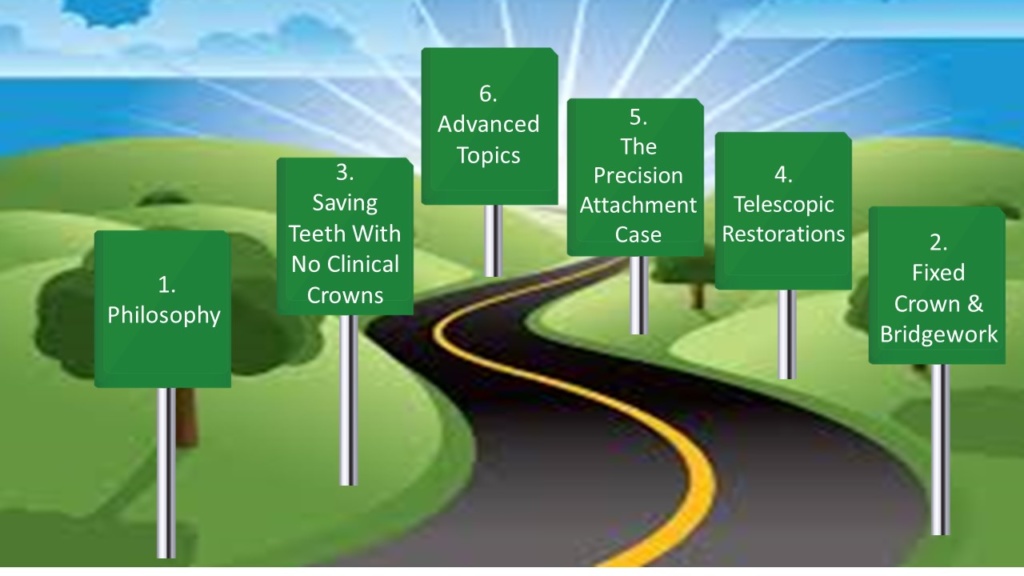SUCCESS PATH
We have arranged the courses in an order we call the “Success Path.” This means that the courses will have pre-requisites to take them. It has been our experience that without taking the courses in order students are never really able to understand the approach to full coverage restorative dentistry that we strive to teach.If you follow our success path, a whole new world will open for you and you will be taken to heights you never believed were possible.
1. Philosophy
Philosophy is the foundation for all that follows and introduces an entirely new approach to full coverage restorative dentistry. Here you will learn a new approach to diagnosis and treatment planning, as well as diagnostic appliance therapy.
2. Fixed Crown and Bridgework
This section covers the why and how offixed crown and bridgework. A three
dimensional,step-by-step approach assures a successful outcome with no
guesswork.
3. Saving Teeth with No Clinical Crowns.
Here you will learn how to save teeth flush with the gingiva without posts or
buildups. Also covered is how to make temporary and permanent
restorations for these teeth that do not decay or fall out.
4. Telescopic crowns
In this section you will learn new options for treatment that you can offer
your patients, and how to build a contingency into your treatment plan for
that weak abutment.
5. The Precision Attachment Case
In this section you will learn a treatment option that few dentists know
anything about. The Double-Tilt Precision Attachment Case has perhaps the best track record in Dentistry and is every bit as good as fixed bridgework. Avoid the pitfalls of fixed bridgework on patients who are not good candidates for implant placement.
6. Advanced topics
Education never stops. With your new foundation and approach to full coverage restorative dentistry the sky’s the limit. We embrace new ideas and we will examine them in the context of the basic principles we believe in.
Please Note:
The Dental Corporate World is only concerned with profits and as a result, they have discontinued several items that are important to the techniques described on this website and in publications (particularly the Double-Tilt Precision Attachment Case for Natural Teeth and Implants). There is no way to appeal their decisions and they refuse to look at anything other than their bottom lines.
Because satisfying the basic principles is what is most important, there are some alternatives:
- Copper Bands: Copper band manufacturing has been discontinued. Many companies have the means and the machines to make the copper bands, but they refuse to make them. Fortunately, Aluminum Shells are widely available in the exact same sizes as copper bands and they can be used in the same way. They are closed on one end. You can drill a hole in the closed end or cut off the closed end with a disk to take individual impressions. To make banded temporaries, the closed end of the aluminum band must be removed. Be careful if you have to anneal aluminum bands to make them more malleable. A copper band cannot be over heated, but an aluminum band that is overheated will disintegrate.
- Male-Female Precision Attachment: There is no company that currently makes a male-female precision attachment. All the attachments on the market grip and lock the abutment teeth or implants. However, Brian Connors at the Creodent Laboratory in Manhattan has designed male-female patterns on the computer that can be cast in the Ceramicor® material for use in the same way described in the Attachment Courses and the Book. The Ceramicor® material consists of 60% Au, 19%Pt, 20%Pd, 1%Ir and melts at 1400-14900C. The original male-female attachments were all cast. At present it is not possible to mill the attachments, but the Strategy Milling Company in Pittsburgh, PA is researching this possibility. Brian can be reached at:
-
-
- Creodent Laboratory
- Address: 545 W 45th Street, 11F; New York, NY 10036
- Email: bconnerscreo@gmail.com
- Tel: 212-302-3860; 888-803-4242
-
3. Triad Composite Reline Material: Dentsply has discontinued this material, even though it is far superior to conventional reline materials. There is no suitable replacement at present. We would welcome any suggestions for materials that might be used in the same manner.

